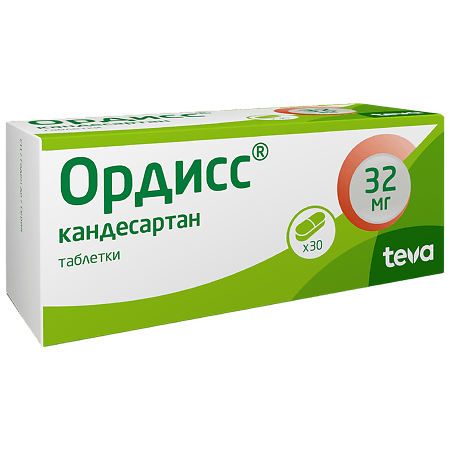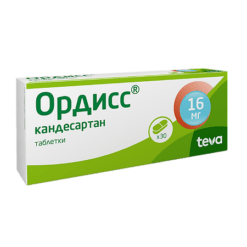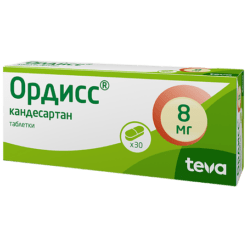No products in the cart.
Ordiss, 32 mg tablets 30 pcs
€31.71 €26.43
Description
Pharmacotherapeutic group: angiotensin II receptor antagonist.
ATX code: C09CA06
Pharmacological properties
Pharmacodynamics
Indications
Indications
• Arterial hypertension.
• Chronic heart failure and impaired left ventricular systolic function (decrease in LVEF ≤ 40%) as additional therapy to angiotensin-converting enzyme (ACE) inhibitors or in case of intolerance to ACE inhibitors (see section “Pharmacodynamics”).
Pharmacological effect
Pharmacological effect
Pharmacotherapeutic group: angiotensin II receptor antagonist.
ATX code: C09CA06
Pharmacological properties
Pharmacodynamics
Special instructions
Special instructions
Concomitant use of ACE inhibitors, ARB II or aliskiren increases the risk of hypotension, hyperkalemia and renal dysfunction (including acute renal failure). Double blockade of the RAAS with simultaneous use of ACE inhibitors, ARB II with drugs containing aliskiren is contraindicated in patients with diabetes mellitus and/or with moderate or severe renal failure (glomerular filtration rate (GFR) less than 60 ml/min/1.73 m2 body surface area) and is not recommended in other patients (see section “Interaction with other drugs”).
If double blockade of the RAAS is considered absolutely necessary, then treatment should only occur under the supervision of a physician and should be accompanied by careful and regular monitoring of renal function, electrolytes and blood pressure. Concomitant use of angiotensin II receptor antagonists with ACE inhibitors is contraindicated in patients with diabetic nephropathy and is not recommended in other patients.
Renal dysfunction. During the use of the drug Ordiss®, as with the use of other drugs that inhibit the RAAS, in some cases, renal dysfunction may develop.
When using the drug Ordiss® in patients with arterial hypertension and severe renal failure (GFR less than 30 ml/min/1.73 m2 body surface area), it is recommended to regularly monitor the potassium content and creatinine concentration in the blood serum. Clinical experience with the drug in patients with end-stage renal failure (GFR less than 15 ml/min/1.73 m2 body surface area) is limited. When using the drug Ordiss® in such patients, it is necessary to select the dose of the drug Ordiss® under blood pressure control.
In patients with CHF, renal function should be periodically monitored, especially in patients over 75 years of age and patients with impaired renal function. When increasing the dose, it is also recommended to monitor the potassium content and creatinine concentration in the blood serum.
There is no data on the use of the drug Ordiss® for CHF with a creatinine concentration of more than 265 µmol/l (more than 3 mg/ml).
Hemodialysis. During hemodialysis, blood pressure may be especially sensitive to AT1 receptor blockade as a result of a decrease in blood volume and activation of the RAAS. Therefore, patients on hemodialysis need to monitor blood pressure and individually select the dose of Ordiss® in accordance with blood pressure levels. Simultaneous use with ACE inhibitors for CHF. When used simultaneously with ACE inhibitors, the risk of side effects increases, especially renal dysfunction and hyperkalemia. The clinical condition of patients and relevant laboratory parameters should be monitored.
Renal artery stenosis. Drugs that affect the RAAS (eg, ACE inhibitors) may cause increases in serum urea and creatinine concentrations in patients with bilateral renal artery stenosis or arterial stenosis of a solitary kidney. A similar effect can be expected with the use of angiotensin II receptor antagonists.
Kidney transplantation. There is no experience with the use of Ordiss® in patients who have recently undergone kidney transplantation.
Arterial hypotension. In patients with CHF, arterial hypotension may develop when using the drug Ordiss®. It is also possible to develop arterial hypotension in patients with BCC deficiency, for example, when using large doses of diuretics. In this case, before using the drug Ordiss®, it is necessary to correct the blood volume.
General anesthesia and/or surgical interventions. In patients receiving angiotensin II antagonists, hypotension may develop during general anesthesia and during surgery as a result of blockade of the RAAS. In rare cases, hypotension may be severe, requiring intravenous fluids and/or vasopressors.
Stenosis of the aortic and/or mitral valves, HOCM. When using the drug Ordiss® in patients with HOCM or hemodynamically significant stenosis of the aortic or mitral valves, caution should be exercised.
Primary hyperaldosteronism. Patients with primary hyperaldosteronism are usually resistant to therapy with antihypertensive drugs that affect the RAAS, so the use of Ordisc® in this group of patients is not recommended.
Hyperkalemia. Concomitant use of Ordiss® with potassium-sparing diuretics, potassium preparations or salt substitutes containing potassium, or other drugs that can increase serum potassium levels (for example, heparin) may lead to the development of hyperkalemia in patients with arterial hypertension.
® Hyperkalemia can also develop in patients with CHF taking the drug Ordiss. During therapy with Ordiss® in patients with CHF, it is recommended to periodically monitor potassium levels in the blood serum, especially with the simultaneous use of ACE inhibitors and potassium-sparing diuretics (spironolactone, triamterene, amiloride, eplerenone (spironolactone derivative)).
General. Patients whose vascular tone and renal function are predominantly dependent on the activity of the RAAS (for example, patients with severe chronic heart failure, kidney disease, including renal artery stenosis) are especially sensitive to drugs acting on the RAAS. The use of such drugs is accompanied in these patients by severe arterial hypotension, azotemia, oliguria and, less commonly, acute renal failure. The possibility of developing the listed effects cannot be excluded when using angiotensin II receptor antagonists. A sharp decrease in blood pressure in patients with ischemic cardiopathy, cerebrovascular diseases of ischemic origin when using any antihypertensive drugs can lead to the development of myocardial infarction or stroke.
Application in pediatrics. The safety and effectiveness of using the drug Ordiss® in people under 18 years of age have not been established.
Impact on the ability to drive vehicles and machinery
Active ingredient
Active ingredient
Candesartan
Composition
Composition
1 tablet contains: active ingredient candesartan cilexetil 8.00 mg/16.00 mg/32.00 mg; excipients: pregelatinized corn starch 3.75 mg/7.50 mg/15.00 mg; poloxamer 188 0.50 mg/1.00 mg/2.00 mg; povidone-K30 4.00 mg/8.00 mg/16.00 mg; red iron oxide dye (E172) 0.075 mg/0.15 mg/0.30 mg; carmellose calcium 1.65 mg/3.30 mg/6.60 mg; microcrystalline cellulose 17.50 mg/35.00 mg/70.00 mg; lactose monohydrate 43.725 mg/87.45 mg/174.90 mg; magnesium stearate 0.80 mg/1.60 mg/3.20 mg.
Pregnancy
Pregnancy
The drug Ordiss® is contraindicated for use during pregnancy due to the fact that candesartan has a direct effect on the RAAS, can cause disturbances in fetal development or have a negative effect on the newborn, including death. If pregnancy is detected during treatment with the drug Ordiss®, the drug must be discontinued immediately. When planning pregnancy, it is necessary to transfer the patient to adequate alternative therapy approved for use during pregnancy.
Contraindications
Contraindications
Hypersensitivity to candesartan and other components of the drug; lactose intolerance; lactase deficiency; glucose-galactose malabsorption syndrome; severe liver dysfunction and/or cholestasis; pregnancy; breastfeeding period; children under 18 years of age; simultaneous use with aliskiren or drugs containing aliskiren in patients with diabetes mellitus and/or moderate or severe renal impairment (glomerular filtration rate (GFR) less than 60 ml/min/1.73 m2 body surface area), simultaneous use with ACE inhibitors in patients with diabetic nephropathy.
With caution
Hemodynamically significant stenosis of the aortic and mitral valves, cerebrovascular diseases, coronary heart disease (CHD), hypertrophic obstructive cardiomyopathy (HOCM), condition after kidney transplantation, bilateral renal artery stenosis or stenosis of the artery of a solitary kidney, primary hyperaldosteronism, severe renal failure (creatinine clearance (CC) less than 30 ml/min), hemodialysis, hyperkalemia; in patients with reduced circulating blood volume (CBV), general anesthesia and surgical interventions (risk of developing arterial hypotension due to blockade of the RAAS).
Side Effects
Side Effects
Arterial hypertension
Side effects during clinical studies were moderate and transient. The overall incidence of side effects while taking candesartan did not depend on the dose of the drug, gender and age of the patient. Discontinuation rates due to side effects were similar between candesartan cilexetil (3.1%) and placebo (3.2%). In a pooled analysis of clinical trial data in patients with arterial hypertension, adverse reactions were identified when using candesartan cilexetil, which were observed with a frequency of at least 1% more than in the placebo group. The most commonly reported adverse reactions were dizziness/vertigo, headache and respiratory infections.
The following are adverse reactions recorded during clinical trials and during post-registration use: very often – 1/10 prescriptions (> 10%), often – from 1/100 prescriptions (> 1% and 0.1% and 0.01% and < 0.1%), very rarely - from < 1/10,000 prescriptions (< 0.01%), frequency unknown (cannot be determined based on available data).
Infectious and parasitic infections: often – respiratory infections.
Disorders of the blood and lymphatic system: very rarely – leukopenia, neutropenia, agranulocytosis.
Metabolic and nutritional disorders: very rarely – hyperkalemia, hyponatremia.
Nervous system disorders: often – dizziness/vertigo, headache. Disorders of the respiratory system, chest and mediastinal organs: very rarely – cough.
Gastrointestinal disorders: very rarely – nausea; frequency unknown – diarrhea.
Disorders of the liver and biliary tract: very rarely – increased activity of liver enzymes, impaired liver function or hepatitis.
Disorders of the skin and subcutaneous tissues: very rarely – angioedema, skin rash, itching, urticaria.
Disorders of the musculoskeletal system and connective tissue: very rarely – back pain, arthralgia, myalgia.
Renal and urinary tract disorders: often – impaired renal function, including renal failure in predisposed patients.
Laboratory parameters: In general, no clinically significant changes in standard laboratory parameters were observed with the use of candesartan cilexetil. As with the use of other drugs that affect the RAAS, a slight decrease in hemoglobin was observed. When using candesartan, regular monitoring of laboratory parameters is usually not required. However, in patients with impaired renal function, it is recommended to periodically monitor potassium levels and serum creatinine concentrations.
Chronic heart failure
Side effects identified during the use of candesartan in adult patients with chronic heart failure were consistent with the pharmacological properties of the drug and depended on the patient’s condition. Clinical studies compared the drug candesartan cilexetil in doses up to 32 mg (n=3803) with placebo (n=3796); 21% of patients in the candesartan cilexetil group and 16.1% of patients in the placebo group discontinued treatment due to adverse reactions. The most common adverse reactions were hyperkalemia, hypotension and renal dysfunction. These reactions were most common in patients over 70 years of age, with diabetes mellitus, or in patients treated with other drugs that affect the RAAS, in particular ACE inhibitors and/or spironolactone.
The following are adverse reactions recorded during clinical trials and during post-registration use: very often – 1/10 prescriptions (> 10%), often – from 1/100 prescriptions (> 1% and 0.1% and 0.01% and < 0.1%), very rarely - from < 1/10,000 prescriptions (< 0.01%), frequency unknown (cannot be determined based on available data).
Disorders of the blood and lymphatic system: very rarely – leukopenia, neutropenia, agranulocytosis.
Metabolic and nutritional disorders: often – hyperkalemia, very rarely – hyponatremia.
Disorders of the skin and subcutaneous tissues: very rarely – angioedema, skin rash, itching, urticaria.
Nervous system disorders: very rarely – dizziness, headache.
Disorders of the respiratory system, chest and mediastinal organs: very rarely – cough.
Gastrointestinal disorders: very rarely – nausea; frequency unknown – diarrhea.
Vascular disorders: often – arterial hypotension.
Disorders of the liver and biliary tract: very rarely – increased activity of liver enzymes, impaired liver function or hepatitis.
Disorders of the musculoskeletal system and connective tissue: very rarely – back pain, arthralgia, myalgia.
Renal and urinary tract disorders: often – impaired renal function, including renal failure in predisposed patients.
Laboratory values: Hyperkalemia and renal dysfunction are common in the treatment of heart failure. It is recommended to periodically monitor potassium levels and creatinine concentrations in the blood serum.
Interaction
Interaction
Dual blockade of the RAAS using angiotensin II receptor antagonists (ARA II), ACE inhibitors or aliskiren (direct renin inhibitor) may be accompanied by an increased risk of arterial hypotension, syncope, hyperkalemia and renal dysfunction (including acute renal failure) compared with monotherapy. Regular monitoring of blood pressure, renal function and electrolyte levels in the blood is necessary in patients taking candesartan and other drugs that affect the RAAS.
Candesartan is contraindicated for use concomitantly with aliskiren or aliskiren-containing drugs in patients with diabetes mellitus and/or with moderate or severe renal impairment (GFR less than 60 ml/min/1.73 m2 body surface area) and is not recommended in other patients.
Concomitant use of angiotensin II receptor antagonists with ACE inhibitors is contraindicated in patients with diabetic nephropathy and is not recommended in other patients.
With simultaneous use of ACE inhibitors and dipeptidyl peptidase type 4 inhibitors (for example, vildagliptin), the risk of developing angioedema may be increased. With simultaneous use of candesartan with hydrochlorothiazide, warfarin, digoxin, oral contraceptives (ethinyl estradiol/levonorgestrel), glibenclamide, nifedipine and enalapril, clinically significant drug interactions
was not identified. Candesartan is metabolized in the liver to a small extent with the participation of the CYP2C9 isoenzyme. Interaction studies have not revealed the effect of candesartan on the CYP2C9 and CYP3A4 isoenzymes; the effect on other isoenzymes of the cytochrome P450 system has not been studied. The simultaneous use of candesartan with other antihypertensive drugs enhances the antihypertensive effect.
Experience with the use of other drugs acting on the RAAS shows that concomitant therapy with potassium-sparing diuretics, potassium preparations, salt substitutes containing potassium, and other drugs that increase potassium levels in the blood serum (for example, heparin) can lead to the development of hyperkalemia.
With the simultaneous use of lithium preparations and ACE inhibitors, a reversible increase in the concentration of lithium in the blood serum and the development of toxic reactions occur. Similar reactions can also occur when using angiotensin II receptor antagonists, and therefore it is recommended to monitor the lithium content in the blood serum.
Concomitant use with non-steroidal anti-inflammatory drugs (NSAIDs), including selective cyclooxygenase-2 (COX-2) inhibitors, acetylsalicylic acid (more than 3 g/day) and non-selective NSAIDs, may reduce the antihypertensive effect of candesartan and may also lead to an increased risk of renal dysfunction, including the development of acute renal failure and an increase in serum potassium. The combination of these drugs should be used with caution, especially in elderly patients.
Overdose
Overdose
Symptoms: analysis of the pharmacological properties of the drug suggests that the main manifestation of an overdose may be a clinically pronounced decrease in blood pressure and dizziness. Isolated cases of drug overdose (up to 672 mg of candesartan) have been described, resulting in the recovery of patients without serious consequences.
Treatment: with the development of a clinically significant decrease in blood pressure, it is necessary to carry out symptomatic treatment and monitor the patient’s condition. Place the patient on his back and elevate his legs. If necessary, the volume of blood volume should be increased, for example, by intravenous administration of 0.9% sodium chloride solution. If necessary, sympathomimetic agents can be used. Removal of candesartan by hemodialysis is ineffective.
Storage conditions
Storage conditions
At a temperature not exceeding 25 °C, in the original packaging. Keep out of the reach of children!
Shelf life
Shelf life
2 years. Do not use after expiration date.
Manufacturer
Manufacturer
Pliva Hrvatska d.o.o., Croatia
Additional information
| Shelf life | 2 years. Do not use after the expiration date. |
|---|---|
| Conditions of storage | At a temperature not exceeding 25 ° C, in the original package. Keep out of reach of children! |
| Manufacturer | Pliva Hrvatska d.o.o., Croatia |
| Medication form | pills |
| Brand | Pliva Hrvatska d.o.o. |
Other forms…
Related products
Buy Ordiss, 32 mg tablets 30 pcs with delivery to USA, UK, Europe and over 120 other countries.

















